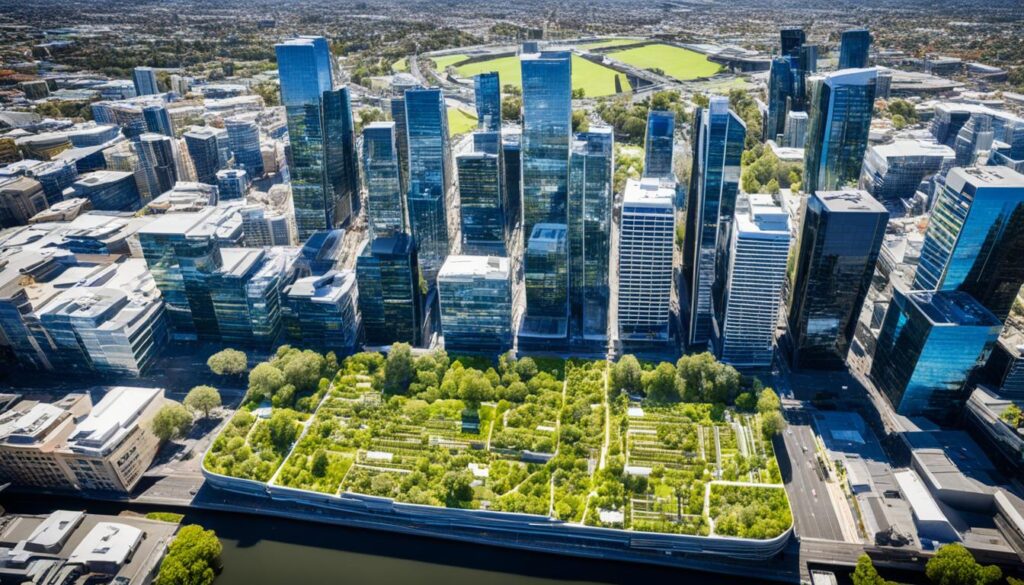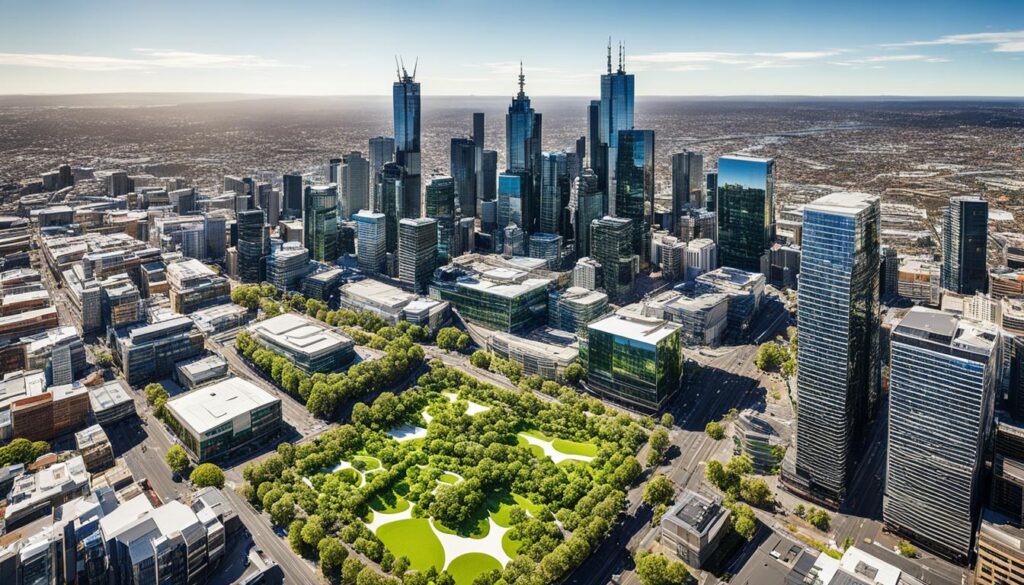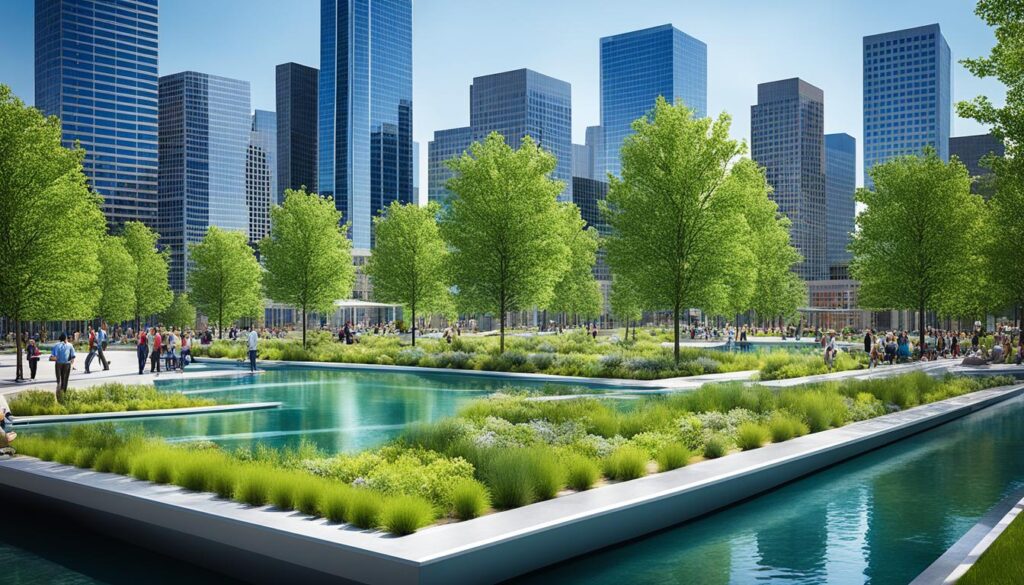Welcome to our article on how green infrastructure is reducing the urban heat island effect in Melbourne. As temperatures continue to rise, it is crucial to find solutions that enhance the livability of our cities. Green infrastructure plays a vital role in achieving this goal by mitigating the adverse effects of urban heat. In this article, we will explore the concept of green infrastructure, its benefits, and how Melbourne is implementing sustainable strategies to combat heat island effect.
Key Takeaways
- Green infrastructure is an effective solution for reducing the urban heat island effect in Melbourne.
- By implementing sustainable urban development practices, Melbourne aims to enhance the livability of the city.
- Green technologies play a crucial role in climate change adaptation and heat reduction.
- Melbourne’s cool cities initiatives and strategies are focused on reducing heat island effect.
- Public engagement and collaboration are essential for successful implementation of green infrastructure projects.
Understanding the Urban Heat Island Effect
The urban heat island effect refers to the phenomenon where urban areas experience higher temperatures compared to surrounding rural areas. This effect is caused by various factors, including the concentration of buildings, roads, and infrastructure in cities, which absorb and retain more heat from the sun.
The heat island effect has significant impacts on cities, affecting both the environment and the well-being of residents. Higher temperatures in urban areas can lead to increased energy consumption for cooling, decreased air quality, and heightened heat-related health risks.
To combat the urban heat island effect, cities have implemented various strategies aimed at reducing temperatures and creating more comfortable living environments. These strategies focus on incorporating green spaces, implementing sustainable design practices, and utilizing innovative technologies.
Here are some key heat island reduction strategies:
- Increasing vegetation: Planting trees, creating green roofs, and establishing urban forests help to provide shade, reduce surface temperatures, and enhance evaporative cooling.
- Implementing cool roof technologies: Using reflective materials on roofs reduces the absorption of solar radiation, lowering surface temperatures and energy consumption for cooling.
- Promoting green infrastructure: Integrating sustainable drainage systems, green walls, and permeable pavements helps to manage stormwater, reduce heat buildup, and improve overall urban resilience.
- Encouraging building design modifications: Adopting passive cooling techniques, such as natural ventilation, shading devices, and building orientation, can significantly reduce indoor temperatures and energy usage.
“The urban heat island effect can have detrimental consequences for the environment and human health. Employing heat island reduction strategies is crucial for creating sustainable and livable cities.”
The table below provides a comparison of different heat island reduction strategies:
| Heat Island Reduction Strategies | Benefits | Challenges |
|---|---|---|
| Increasing vegetation | – Provides shade and lowers surface temperatures. – Enhances air quality and biodiversity. |
– Requires long-term maintenance. – Limited space for tree planting. |
| Implementing cool roof technologies | – Reduces surface temperatures and energy consumption for cooling. – Extends the lifespan of roof materials. |
– Initial installation costs. – Limited effectiveness in colder climates. |
| Promoting green infrastructure | – Manages stormwater and reduces heat buildup. – Enhances urban resilience and ecological connectivity. |
– Requires careful planning and integration. – Limited space for implementation. |
| Encouraging building design modifications | – Reduces indoor temperatures and energy usage. – Enhances occupant comfort and productivity. |
– May require retrofitting existing buildings. – Architects and builders need to be receptive to sustainable design principles. |
By implementing these strategies, cities can effectively reduce the urban heat island effect and its associated negative impacts. The use of green infrastructure, sustainable design practices, and innovative technologies plays a vital role in creating cooler and more livable urban environments.
Green Infrastructure as a Solution
Green infrastructure plays a crucial role in mitigating urban heat and promoting sustainable urban development. By incorporating nature-based solutions into city planning, we can effectively manage heat and create healthier and more livable urban environments.
One of the key benefits of green infrastructure is its ability to reduce the urban heat island effect. This phenomenon occurs when cities experience significantly higher temperatures compared to surrounding rural areas due to human activities and the built environment. Green infrastructure, such as parks, urban forests, green roofs, and green walls, helps to counteract this effect by providing shade, evapotranspiration, and cooling through natural vegetation and water features.
Benefits of Green Infrastructure in Urban Heat Management
- Temperature reduction: Green infrastructure helps to cool urban areas by providing shade and reducing the amount of heat-absorbing surfaces like concrete and asphalt.
- Air quality improvement: Vegetation in green infrastructure helps to filter pollutants from the air, resulting in cleaner and healthier urban environments.
- Stormwater management: Green infrastructure features like rain gardens and bioswales help to absorb and filter stormwater, reducing the risk of flooding and improving water quality.
- Biodiversity preservation: By creating green corridors and habitat patches, green infrastructure supports the conservation of urban biodiversity, enhancing the overall ecological balance of cities.
- Enhanced livability: Access to green spaces and nature has been linked to improved mental health, reduced stress levels, and increased social cohesion within communities.
By incorporating green infrastructure into urban planning, we can achieve sustainable and climate-resilient cities. It is essential to prioritize the integration of green infrastructure in future urban development projects to create greener, healthier, and more livable urban environments.
| GREEN INFRASTRUCTURE | Benefits |
|---|---|
 |
Provides shade, reduces air pollution, enhances biodiversity |
| Green Roofs and Walls | Improves energy efficiency, reduces urban heat island effect, manages stormwater runoff |
| Rain Gardens and Bioswales | Filters stormwater, reduces flood risks, improves water quality |
Investing in sustainable urban development practices that prioritize the integration of green infrastructure is crucial for cities like Melbourne. By implementing a comprehensive strategy that balances economic growth, social well-being, and environmental sustainability, we can create vibrant and resilient urban spaces that benefit both current and future generations.
Green Technologies for Heat Reduction
In our efforts to combat the adverse effects of climate change and create more sustainable and resilient cities, it is crucial to explore the potential of green technologies in reducing heat in urban areas. These innovative solutions harness the power of nature and technology to mitigate the urban heat island effect and contribute to climate change adaptation.
One effective green technology for heat reduction is the use of cool roofs. Cool roofs are designed to reflect more sunlight and absorb less heat compared to traditional roofs. By installing cool roofs on buildings, we can significantly reduce the amount of heat absorbed, resulting in lower indoor temperatures and reduced energy consumption for cooling.
“Cool roofs help to minimize the heat island effect by reflecting sunlight away from buildings, reducing the need for air conditioning and saving energy.”
Another promising green technology is the implementation of green walls and roofs. These living systems utilize vegetation to provide insulation and evaporative cooling, thereby lowering ambient temperatures. Green walls and roofs also improve air quality, provide habitat for wildlife, and enhance the aesthetic appeal of urban spaces.
Furthermore, the use of smart sensors and advanced data analytics can optimize the energy efficiency of buildings and infrastructure. By monitoring and analyzing temperature patterns, energy usage, and environmental conditions in real-time, we can identify areas of excessive heat and implement targeted solutions for heat reduction. Smart technologies also enable us to adjust cooling systems and optimize energy consumption based on demand and external factors.
Additionally, the integration of renewable energy sources such as solar panels can help reduce reliance on fossil fuels for energy generation. Solar panels capture clean and renewable energy from the sun and convert it into electricity, providing a sustainable and climate-friendly power source. By embracing renewable energy technologies, we can reduce greenhouse gas emissions and mitigate the impacts of climate change.
When it comes to heat reduction, it is important to consider the holistic approach of combining multiple green technologies. Implementing a combination of cool roofs, green walls and roofs, smart sensors, and renewable energy sources can yield synergistic benefits, enhancing the overall effectiveness of heat reduction efforts in urban areas.
Benefits of Green Technologies for Heat Reduction:
- Lower indoor temperatures and reduced energy consumption for cooling
- Improved air quality and enhanced aesthetics of urban spaces
- Optimized energy efficiency and reduced greenhouse gas emissions
- Sustainable and climate-friendly power generation
Now, as we explore the role of green technologies in heat reduction, let’s take a moment to visualize how these innovations can transform our cities. See the image below:
By embracing green technologies, we can pave the way for climate change adaptation and create cooler and more sustainable urban environments.
Melbourne’s Approach to Green Infrastructure
When it comes to combatting the urban heat island effect, Melbourne has adopted a proactive approach by implementing various green infrastructure strategies. The city recognizes the importance of creating cool and sustainable urban environments for its residents and is committed to reducing the heat island effect through innovative initiatives.
One of the key programs that Melbourne has embraced is its cool cities initiative. This initiative focuses on transforming the city’s urban landscape to promote a cooler climate and enhance livability. Through the cool cities program, Melbourne aims to reduce the ambient temperature, improve air quality, and create more pleasant public spaces for its residents.
“Our cool cities initiative is a testament to our commitment to prioritizing the well-being and comfort of our residents. By implementing green infrastructure strategies, we are transforming Melbourne into a more sustainable and enjoyable city to live in.”
– Mayor of Melbourne
Melbourne’s approach to green infrastructure involves the widespread implementation of various strategies that contribute to heat island reduction. These strategies include:
- Increasing the city’s urban green spaces by planting more trees and creating parks and gardens
- Installing green roofs and walls on buildings to improve insulation and reduce surface temperatures
- Implementing permeable pavements to enhance rainwater absorption and decrease heat buildup
- Promoting sustainable transportation options, such as cycling lanes and pedestrian-friendly infrastructure, to reduce vehicular emissions and mitigate heat
By adopting these heat island reduction strategies, Melbourne aims to create a more sustainable and resilient city that can effectively manage high temperatures and provide a comfortable living environment for its residents.

Let’s take a closer look at the impact of Melbourne’s green infrastructure initiatives in the table below:
| Impact | Green Infrastructure Initiatives |
|---|---|
| Temperature reduction | Increased urban green spaces, green roofs, and walls |
| Air quality improvement | Increased vegetation absorbs pollutants and reduces air pollution |
| Stormwater management | Permeable pavements enhance rainwater absorption and reduce flooding risks |
| Energy efficiency | Green roofs and walls improve building insulation, reducing the need for energy-intensive cooling systems |
Case Study: Royal Park
A stellar example of Melbourne’s green infrastructure success is the transformation of Royal Park. Royal Park underwent a major redevelopment that involved the introduction of green roofs, tree planting, and the creation of natural wetlands. These interventions have significantly reduced the temperature and provided a recreational space that is both cool and inviting for visitors.
Melbourne’s approach to green infrastructure sets an inspiring precedent for other cities striving to create sustainable and livable environments. By implementing heat island reduction strategies and embracing cool cities initiatives, Melbourne is leading the way towards a greener and cooler future.
Benefits of Green Infrastructure in Melbourne
Green infrastructure plays a crucial role in contributing to sustainable urban development and effective management of urban heat in Melbourne. By incorporating nature-based solutions into the city’s infrastructure, we can create a more livable and resilient environment for both residents and the natural ecosystem.
Improved Urban Cooling
One of the key benefits of green infrastructure is its ability to cool urban areas. By strategically planting trees and creating green spaces, we can reduce the urban heat island effect, where built-up areas trap and retain heat, causing higher temperatures. Green infrastructure helps to lower surface and air temperatures, creating a more comfortable and healthier environment for everyone.
Enhanced Air Quality
Green infrastructure not only helps to regulate temperature but also improves air quality in cities. Trees and vegetation act as natural filters, removing pollutants and particulate matter from the air. This reduces the risk of respiratory diseases and improves overall air quality, promoting healthier living conditions for residents.
Stormwater Management
Another notable benefit of green infrastructure is its ability to manage stormwater. By incorporating green roofs, rain gardens, and permeable surfaces, we can mitigate issues such as flooding and sewer overflow. Green infrastructure helps to absorb and filter rainwater, reducing the strain on drainage systems and improving water quality.
Biodiversity Conservation
Integrating green infrastructure into urban areas also supports biodiversity conservation. By creating green corridors and preserving natural habitats, we provide refuge for native species and promote ecological balance. This biodiversity not only enhances the beauty of the city but also contributes to the overall health and resilience of the ecosystem.
“Green infrastructure has the potential to transform our cities into vibrant and sustainable spaces, benefiting both people and the environment.” – Dr. Emily Green, Urban Ecology Researcher
Green infrastructure offers a multitude of benefits for Melbourne, ranging from improved urban cooling and enhanced air quality to stormwater management and biodiversity conservation. By investing in sustainable urban development practices that prioritize green infrastructure, we can create a greener, healthier, and more resilient city for generations to come.
| Benefits of Green Infrastructure in Melbourne |
|---|
| Improved Urban Cooling |
| Enhanced Air Quality |
| Stormwater Management |
| Biodiversity Conservation |
Case Studies of Successful Green Infrastructure Projects
In this section, we will explore real-life case studies of successful green infrastructure projects in Melbourne. These projects serve as inspiring examples of how green infrastructure can contribute to sustainable urban development and effective heat reduction.
Case Study 1: The Royal Park Wetland
The Royal Park Wetland is a remarkable green infrastructure project in Melbourne that showcases the city’s commitment to sustainable urban development. Built in 2010, this wetland system plays a crucial role in managing stormwater and improving water quality.
Designed to mimic the natural wetlands, it incorporates a series of ponds and channels that collect and treat stormwater runoff from nearby urban areas. The wetland not only filters pollutants but also provides a habitat for a variety of plant and animal species.

Case Study 2: Green Roofs in Melbourne Central Business District
The implementation of green roofs in the Melbourne Central Business District (CBD) has been highly successful in reducing the heat island effect and promoting sustainable urban development. One notable example is the World Trade Centre (WTC) in Melbourne.
The WTC features an impressive green roof that spans several thousand square meters. This green roof not only provides insulation, reducing the energy demand for cooling and heating, but also enhances stormwater management by absorbing and retaining rainwater.
Furthermore, these green roofs create green spaces within the CBD, improving the liveability and well-being of residents and workers. The greenery not only adds aesthetic value but also contributes to air purification and biodiversity conservation.
Case Study 3: The Melbourne Urban Forest Strategy
The Melbourne Urban Forest Strategy is a comprehensive initiative that aims to increase canopy cover and create a greener city. Through the incorporation of trees, gardens, and parks into urban spaces, Melbourne is actively combating the urban heat island effect and promoting sustainable urban development.
One of the notable projects resulting from this strategy is the rejuvenation of City Square. Formerly a hot and barren space, City Square has been transformed into a lush green oasis with trees, gardens, and seating areas. This revitalization not only enhances the visual appeal of the area but also provides a shaded and comfortable environment for the community to enjoy.
Case Study 4: The Southbank Promenade Green Spine
The Southbank Promenade Green Spine is a prime example of how green infrastructure can be integrated into existing urban environments to create vibrant and sustainable spaces. This project has successfully transformed a concrete promenade into a green corridor that connects key landmarks.
The Green Spine features a combination of trees, plants, seating areas, and walking paths, enhancing the aesthetics of the waterfront while providing shade, improving air quality, and reducing the heat island effect. It has transformed the area into a popular destination for residents and tourists, contributing to the overall livability of Melbourne.
Public Engagement and Collaboration for Green Infrastructure
In order to successfully implement green infrastructure projects in Melbourne and effectively address the challenges of climate change adaptation, public engagement and collaboration play a vital role. Engaging with the community and involving citizens in decision-making processes not only fosters a sense of ownership but also ensures that diverse perspectives and needs are considered.
One of the key strategies employed by Melbourne in promoting public engagement is through the establishment of community forums and consultation processes. These platforms provide an opportunity for residents, businesses, and other stakeholders to share their ideas, concerns, and aspirations regarding green infrastructure initiatives. By actively involving the public, we can ensure that the projects align with the community’s needs and aspirations, promoting a sense of inclusivity and shared responsibility for climate change adaptation.
We believe that through collaborative efforts, we can create a more sustainable and resilient Melbourne, capable of effectively managing the impacts of climate change. By listening to the voices of the community, we gain valuable insights and ideas, enriching the decision-making process and ensuring the success of green infrastructure projects.
Furthermore, collaboration with various organizations, institutions, and government agencies is crucial in implementing green infrastructure solutions. By working together, we can pool resources, expertise, and knowledge to develop innovative and effective strategies for climate change adaptation.
Benefits of Public Engagement and Collaboration
- Enhanced community buy-in and support for green infrastructure projects.
- Creation of a sense of shared responsibility for climate change adaptation.
- Incorporation of diverse perspectives and needs in decision-making processes.
- Increased transparency and trust between stakeholders.
- Fostering of innovation and creativity through the exchange of ideas and expertise.
By actively engaging the public and promoting collaboration, Melbourne empowers its citizens to actively contribute to climate change adaptation efforts. Together, we can create a greener, more vibrant, and resilient city that can effectively combat the impacts of climate change through the implementation of sustainable green infrastructure solutions.
| Benefits of Public Engagement and Collaboration | Related Keywords |
|---|---|
| Enhanced community buy-in and support for green infrastructure projects | community buy-in, support, green infrastructure projects |
| Creation of a sense of shared responsibility for climate change adaptation | shared responsibility, climate change adaptation |
| Incorporation of diverse perspectives and needs in decision-making processes | diverse perspectives, decision-making processes |
| Increased transparency and trust between stakeholders | transparency, trust, stakeholders |
| Fostering of innovation and creativity through the exchange of ideas and expertise | innovation, creativity, exchange of ideas, expertise |
Through public engagement and collaboration, we are paving the way for a more sustainable and climate-resilient future for Melbourne. Together, we can create a city that not only mitigates the impacts of climate change but also provides a better quality of life for all its residents.
Conclusion
In conclusion, the implementation of green infrastructure plays a crucial role in reducing the urban heat island effect in Melbourne. Through the use of green technologies and sustainable urban development practices, we can create cooler and more livable cities.
By strategically integrating green spaces, such as parks, rooftop gardens, and urban forests, we can mitigate rising temperatures and enhance the overall quality of life for residents. These green spaces help to cool the surrounding environment by providing shade, reducing the heat absorbed by buildings and pavement, and increasing natural ventilation.
Furthermore, public engagement and collaboration are key in successfully implementing green infrastructure projects. By involving the community in climate change adaptation efforts, we empower individuals to contribute to the creation of cooler urban environments. Melbourne sets a positive example in this regard, actively engaging its citizens in the development and maintenance of green spaces.
Overall, reducing the urban heat island effect through the implementation of green infrastructure is not only crucial for mitigating the adverse effects of climate change but also for creating more sustainable and livable cities. Melbourne’s efforts in this area serve as an inspiration for other cities around the world, prompting a shift towards greener and more resilient urban landscapes.
FAQ
What is the urban heat island effect?
The urban heat island effect refers to the phenomenon where cities experience higher temperatures compared to surrounding rural areas. It is caused by the concentration of buildings, pavements, and human activities, which absorb and retain heat. This effect can lead to increased energy consumption, decreased air quality, and compromised human health.
How can the urban heat island effect be reduced?
There are various strategies that can be employed to reduce the urban heat island effect. These include implementing green infrastructure, such as parks and green roofs, which help absorb heat and provide shade. Other strategies include using cool materials for pavements and buildings, incorporating water features, and promoting sustainable urban development practices.
What is green infrastructure?
Green infrastructure refers to the integration of natural elements, such as trees, parks, and green spaces, into urban planning and design. It aims to enhance the quality of life in cities by providing multiple benefits, including the reduction of urban heat, improved air quality, stormwater management, and biodiversity conservation.
How does green infrastructure contribute to sustainable urban development?
Green infrastructure plays a crucial role in sustainable urban development by mitigating environmental challenges and improving the overall well-being of urban residents. It helps manage urban heat by providing shade, reducing the need for excessive air conditioning and cooling measures. Green infrastructure also promotes biodiversity, reduces air pollution, and enhances the aesthetics of urban areas.
What are some green technologies used for heat reduction in cities?
There are several green technologies available for reducing heat in urban areas. These include green roofs, which absorb and dissipate heat, and cool pavements that reflect sunlight. Other technologies include solar-powered cooling systems, natural ventilation, and the use of energy-efficient materials in building construction. These technologies contribute to climate change adaptation and promote sustainable urban living.
How is Melbourne addressing the urban heat island effect?
Melbourne has implemented various strategies and initiatives to combat the urban heat island effect. The city has developed cool cities initiatives, which include the implementation of green roofs and walls, increased tree canopy cover, and cool pavement installations. Melbourne also focuses on sustainable urban planning and design to maximize the benefits of green infrastructure in heat reduction and climate adaptation.
What are the benefits of green infrastructure in Melbourne?
Green infrastructure brings numerous benefits to Melbourne. It helps reduce urban heat, improve air quality, manage stormwater runoff, and enhance the overall livability of the city. By integrating natural elements into urban areas, green infrastructure promotes physical and mental well-being, supports biodiversity, and contributes to the city’s resilience against climate change effects.
Can you provide examples of successful green infrastructure projects in Melbourne?
Yes, Melbourne has several successful green infrastructure projects. For instance, the Greening the Pipeline project involved converting an existing pipeline into a linear park with native vegetation and cycling paths. The Queen Victoria Market Precinct Renewal Project incorporated green spaces, water-sensitive design, and energy-efficient buildings. These projects showcase the effectiveness of green infrastructure in creating sustainable and cooler urban environments.
How can the public be engaged in green infrastructure projects?
Public engagement and collaboration are crucial for the success of green infrastructure projects. In Melbourne, the public is involved in the planning and implementation processes through community consultations, educational workshops, and volunteer programs. By engaging citizens, the city ensures that green infrastructure projects align with local needs and preferences while fostering a sense of ownership and pride among residents.
